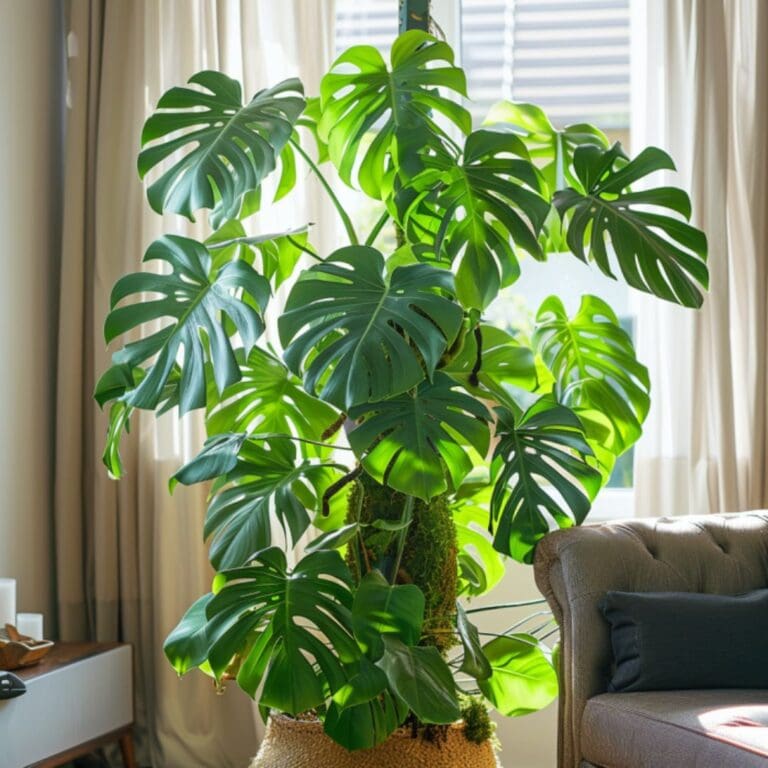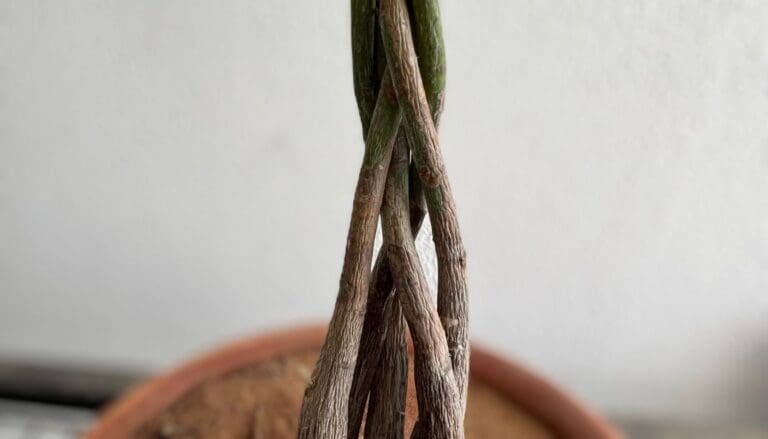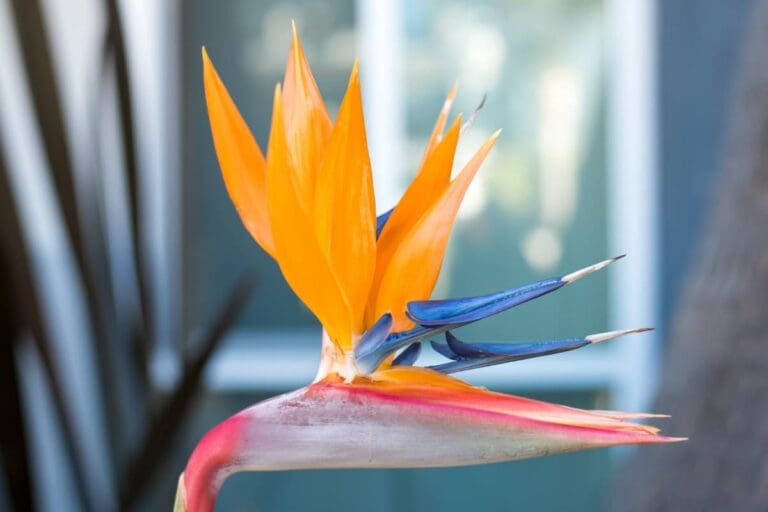What Kind Of Pot For Alocasia? (Pot Material & Ideal Pot Size)
Have you ever wondered what kind of pot is best for your Alocasia plant? In this article, we will talk about the different types of pots and the ideal size for your Alocasia.
Clay pots are the most preferred for alocasia because they are porous, allowing airflow into the roots and soil. You can also use ceramic or plastic pots. Choosing the pot size is equally important; the ideal pot size should not be more than 1-2 inches bigger than your present pot.
To help you choose the kind of pot for your Alocasia, I will also discuss the pros and cons of the different pots in this article.

Please note: Simplify Plants is reader-supported. Some links in the post are affiliate links and I get a commission from purchases made through links in the post.
Which pot size is suitable for Alocasia?
While growing a houseplant, the pot size matters a lot.
Because the entire growth of Alocasia is confined in the pot, it must be of the correct size to provide the support it needs.
When it comes to alocasia, you cannot and should not grow them in a pot of the wrong size.
A pot that is too big or small for Alocasia will impact its growth.
When choosing a pot for your Alocasia, do not ignore the importance of the size and get a pot that is no more than 1-2 inches bigger than your present pot.
There are several drawbacks to using a too-big pot for your Alocasia.
A bigger pot with more soil will require more water.
The plant does not absorb this excess water, and it takes much time to dry out.
So the soil remains soggy and damp leading to various diseases in the roots and even root rot.
Another disadvantage of an extremely big pot is that the plant tries hard to spread its roots.
This way, the plant invests more energy in the growth of the roots than in the leaves and blooms.
You should use a big pot only to grow a big voluptuous plant that suits that pot size.
If you keep a small Alocasia in a big pot, its health will be affected.
Many plant owners also grow multiple plants of the same requirements in one big pot.
On the contrary, a pot that is too small for your Alocasia will hamper the plant’s growth too.
The plant can get root-bound quickly in an excessively smaller pot, requiring frequent repotting.
This will give unnecessary stress to the plant affecting its overall health.
Another disadvantage of a small pot is that the soil of your Alocasia would dry out too frequently, which is not right for this plant because they are tropical plants that like moisture to grow.
If the soil consistently keeps getting bone dry, it will affect the plant’s health.
Alocasia plants like remaining slightly cramped, but an excessively small pot will tend to suffocate the roots blocking airflow, which can also be harmful.
Alocasias also grow into robust and large stature; therefore, an excessively small pot can topple on one side due to the weight of the plant.
From this elaborate discussion on the correct pot size of your plant, we can conclude that do not grow your Alocasia in a pot that is more than 1-2 inches bigger than the present pot.
This way, the roots will get space to expand while not too big to trap unnecessary water.
Which pot shape is suitable for Alocasia?
There are many different pots available in the market.
Some are round some square, some rectangle, and some oval.
Most plant owners prefer to use a standard pot with a tapered bottom because the non-tapered bottom pots hold more moisture at the bottom of the pot.
The soil at the top dries, but it remains damp at the bottom, which leads to overwatering problems.
However, if the size, the material is right, and drain holes are present, you can choose the shape you like.
Which pot material is ideal for Alocasia?
After deciding the size of the pot, the next most vital feature while choosing the pot, is the material of the pot.
There are various pots of different materials, each having its features and pros and cons.
Understanding those will help you choose the right material pot for your Alocasia.
Here let us discuss the common pot materials available and the benefits and disadvantages in detail.
Ceramic pots
Most houseplant owners like these because of their chic and elegant visual appeal.
Ceramic pots are not as porous as clay pots and are glazed both inside and outside.
Pros:
- Therefore, they are heavy and can give good support to robust plants, and do not topple over.
- They are less easily broken than clay pots.
- Ceramic pots are good for plants that require moist soil as they are less porous than clay pots.
- The soil does not dry as fast as clay pots.
- They are available in many shapes, sizes, and colors, making them a favorite for plant owners.
Cons:
- Ceramic pots are quite expensive.
- Most of these pots are decorative and do not have drainage holes. This blocks the excess water inside the pot and does not let it flow out, leading to root rots. To solve this, some people drill holes at the bottom, and some use pots with holes to plant the Alocasia and then insert it into this fancy ceramic pot.
- Ceramic pots are heavy and difficult to carry around, so some people fix them on rollers.
Terracotta pots
Plant lovers highly prefer terracotta pots, and most plants thrive best in these pots.
The word “terracotta” means baked earth, as they are made of clay and are unglazed.
Pros:
- Clay pots are highly porous, so the excess water in the soil does not stay trapped in and evaporate.
- There is plenty of airflow in the pot, so the roots do not feel suffocated.
- They come in many sizes and are available for plants of all sizes.
- They are less expensive than ceramic pots.
- They are heavy and have fewer chances to topple over unless the plant grows too big for the pot.
- There is a lesser chance of pests and bugs growing in the soil as air and oxygen are in the soil.
Cons:
- They are quite heavy when big plants are potted, so moving them is difficult.
- They are porous, so the soil dries out frequently between watering.
- Clay pots can break very easily.
Wooden pots
Wooden posts are a growing trend in indoor gardens, and they have started to become popular among houseplant owners.
They are made from wood and can last for a long if taken care of.
Pros:
- Wooden posts can be painted as per choice and given different looks.
- They are cheaper than ceramic pots.
- You can recycle them from old wooden objects like boxes and baskets, which help recycle and reduce waste and are environmentally friendly.
Cons:
- The wood quality declines over time and starts to decay due to moisture.
- These pots can sometimes leak and make the floor messy. You can keep a tray under it to collect the excess water.
- Because wood is porous, the soil will tend to dry faster, so the Alocasia, which likes moisture, must be watered more often.
- To maintain the quality of the wood, you need to maintain it, which is impossible for everyone.
Plastic pots
These are the most popular pot types among indoor gardeners who want hassle-free pots for their plants.
Plastic pots are available in different colors, shapes, and sizes and come cheap.
Pros:
- They are the cheapest among all the types of pots.
- They are very lightweight and can be easily carried around the house.
- They are not breakable, and damage to these pots is very rare.
- It is very suitable for moisture-loving plants because the moisture stays in for a longer time as they are non-porous.
- They are easily available in a large variety almost everywhere.
Cons:
- The major demerit of plastic pots is that they are non-porous, and it does not allow airflow inside the pot, making the soil remain soggy, leading to fungus and diseases.
- If left in the scorching sun for a long time, plastic pots can fade and become brittle.
- You have to be more cautious with overwatering your plant in plastic pots.
Fiberglass pots
A very new pot type in the gardening industry is the fiberglass pot.
They are made from fiberglass fibers and resins and resemble ceramic and plastic pots.
They are lightweight and have many advantages, so they are becoming popular.
Pros:
- They are very lightweight compared to clay or ceramic.
- They are highly durable.
- They are available in a large variety of shapes and sizes.
- They are not porous, and moisture-loving plants thrive in them.
Cons:
- Fiberglass pots are more expensive compared to plastic or terracotta pots.
- They are not porous, so there is always a chance of overwatering.
- They are not as sturdy as plastic pots and can break.
- They start losing their glossy finish after being used for a long time.
Metal pots
Metal pots are unique and bring a different look to the plant garden.
Pros:
- Long-lasting and highly durable.
- They do not break easily.
- They act as unique accent pieces in the indoor garden.
- Available in multiple shapes and sizes.
- You can recycle it from old metal items like pots, drums, etc., only by drilling a hole at the bottom.
Cons:
- Metal pots are non-porous. The soil can remain soggy for a long time.
- It gets heated under direct sunlight, which might heat the soil too.
- Once they are filled with soil, they can become quite heavy to carry.
- They develop rust with time.
- Most metal pots do not have drain holes that you must manually drill.
How do you select the right pot for Alocasia?
Whatever material or shape of the pot you choose, here are a few factors you must remember.
Size
As I have already discussed above, the pot’s size plays a vital role in the health and growth of your Alocasia.
Remember, large and excessively small pots can ruin your plant’s health.
You’re mistaken if you think potting your Alocasia in an excessively large pot will allow the plant to grow without worrying about repotting.
This can lead to several issues like overwatering, root rot, etc.
Similarly, a smaller pot will make the plant need more space to grow to repot it more frequently, causing stress.
So, choose the right pot size that is no more than 2 inches bigger than its root system.
Drainage holes
The importance of drainage holes is vital.
The absence of these can straightaway kill your plant, with all that water accumulating at the bottom, giving rise to pathogens.
Many plant owners like to use fancy decorative pots without drainage holes to grow their Alocasia.
You must never do that.
You can drill a hole or use another pot inside the fancy pot to grow your plant with a hole at the bottom.
Drainage holes let the excess water in the pot flow out, preventing soggy soil and root rot.
Without water, it does not run out and stays at the bottom of the pot, making the roots constantly soggy.
This prevents oxygen supply in the roots leading to bacterial growth.
Cleanliness
Cleaning the pots of the plants to maintain their health is important.
Over time, with constant moisture, soil, water, fertilizer, and dirt building up in the pot, it becomes harmful.
Salt build-ups collected inside the pot can damage the soil and plant.
Also, if the pots are not cleared, they can be passed over to new soil in case of diseases.
In the case of clay pots, washing them helps to dampen them, which helps to preserve moisture in them.
To clean the pots, you can use a brush and water and scrub the pot well.
Once the pot is clean, prepare a solution in a large container with 10% bleach and 90% water, filling the container enough to soak the pot in the solution for 10 minutes.
This solution will kill all the disease-causing microorganisms that may be sticking to the pot’s surface.
If the pot is plastic, rinse it off and let it air dry.
If it is clay, then soak the pot in clean water for 10 minutes to remove the bleach from the pores, then let it air dry.
Repotting

Alocasia plants grow vigorously in the initial stage, requiring repotting every year.
However, once the plant has matured, you can repot it only when it shows rootbound or root rot.
Here are some tips to remember while repotting your Alocasia.
- The new pot should not be 2 inches bigger than the previous pot.
- The soil mix is important. Make sure it is light, well-draining, and at the same time rich enough to provide sufficient nutrients to your Alocasia.
- Water the Alocasia after repotting until it runs off the drainage hole, and keeps it in a bright area away from direct sunlight. Do not disturb the Alocasia and let it settle in the new soil over the next few days.
- Do not fertilize the plant right after repotting because the soil mix you prepare remains quite rich for some time. Overfertilization can lead to root burns.
- Make sure to make the potting mix well-draining by adding perlite, charcoal, sand, coco coir, etc. It prevents the soil from becoming heavy and compact.
Final words
From the above discussion, you must have ideas about the kinds of pots available and their pros and cons. You can choose any pot, provided you maintain your plant’s care routine.
Though Alocasia likes moisture, you must be careful with overwatering if you choose a plastic pot. You can carry the pot to any corner of the house using a plastic pot.
In clay pots, your Alocasia would require more frequent watering. However, due to airflow, overwatering and diseases will be much lower.
You can choose the pot type depending on the kind of care routine you can follow and the visual appeal you want to add to your indoor garden.
Hopefully, this article has helped you understand which pot type would be most suitable for your Alocasia.

Reference: Alocasia sanderiana, Alocasia micholitziana.
Recommended Garden Supplies
| Product Image | Our Recommended Gardening Supplies | Check Offers! |
|---|---|---|
Top Top
Top
Top
Top
Top
Top
Top
Top | rePotme Houseplant and Tropical Classic Potting Soil Mix | Check Offer On Amazon |
 Top
Top
Top
Top
Top
Top
Top
Top | Espoma Organic Indoor Plant Food | Check Offer On Amazon |
 Top
Top
Top
Top
Top
Top
Top
Top | GooingTop LED Grow Light 6000K Full Spectrum Clip Plant Growing Lamp | Check Offer On Amazon |
 Top
Top
Top
Top
Top
Top
Top
Top | Soil Moisture Meter | Check Offer On Amazon |
 Top
Top
Top
Top
Top
Top
Top
Top | Govee Hygrometer Thermometer, Bluetooth Enabled! | Check Offer On Amazon |
 Top
Top | LEVOIT Humidifiers for Large Room(Best For Plants) | Check Offer On Amazon |
 Top
Top
Top
Top
Top
Top
Top
Top | Upgraded DIY Automatic Drip Irrigation Kit, 15 Potted Houseplants Support | Check Offer On Amazon |
 Top
Top
Top
Top
Top
Top
Top
Top | Stainless Steel Heavy Duty Gardening Tool Set | Check Offer On Amazon |
 Top
Top
Top
Top
Top
Top
Top
Top | Bonide Insecticidal Soap | Check Offer On Amazon |
 Top
Top
Top
Top
Top
Top
Top
Top | Bonide 32 oz Spray Neem Oil for Organic Gardening | Check Offer On Amazon |
 Top
Top
Top
Top
Top
Top
Top
Top | Garden Safe Fungicide | Check Offer On Amazon |












